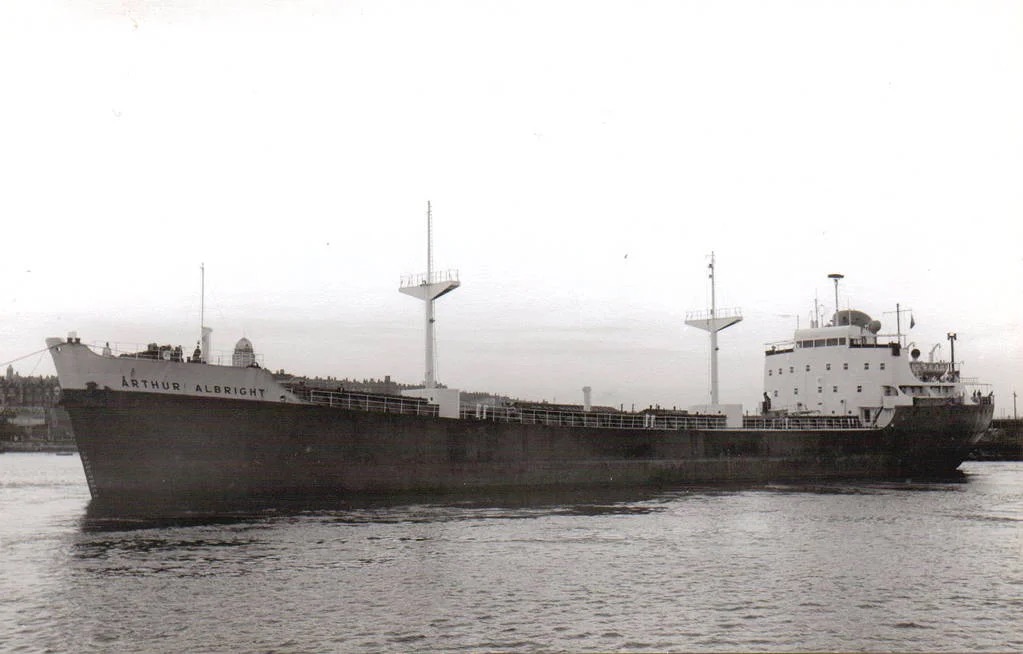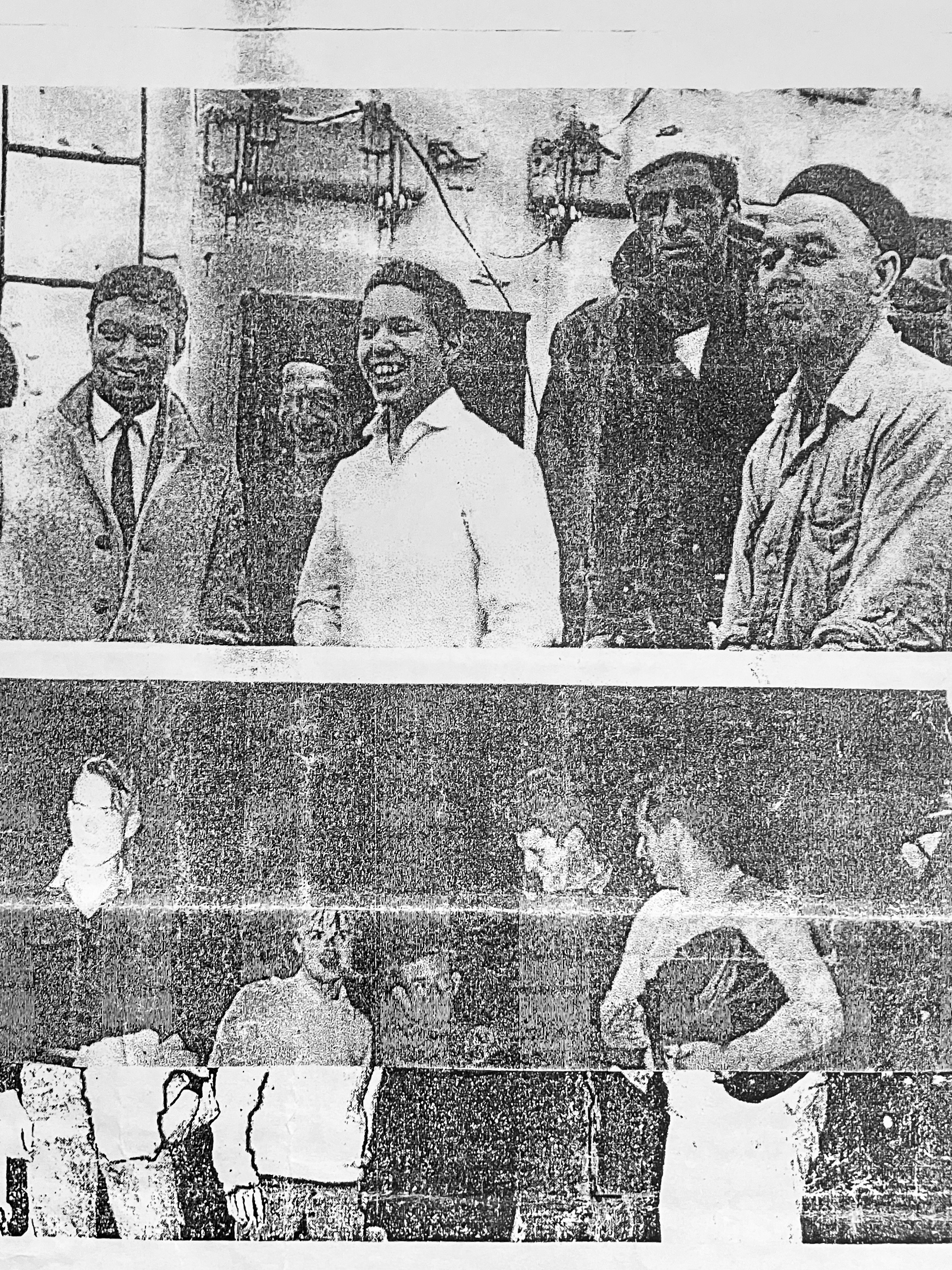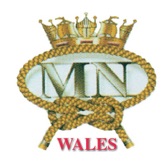CREW OF M.V. Arthur Albright RESCUES SHIPWRECKED DANES
SUBMITTED BY MR. RAY SMITH OF BARRY

A radio S.O.S., heavy seas, searching aircraft, a drifting raft with five men aboard – all part of a stirring sea rescue story in which the crew of the Arthur Albright played a leading part.
The story began on the night of December 7th 1964 when the Radio Officer aboard the Arthur Albright picked up an SOS message from Ilfracombe Radio Station reporting that the Danish coaster Scantic had been shipwrecked 50 miles off the Irish Coast and that the crew had taken to a life raft. An approximate position was given and Captain Bristow realised that it was on an almost identical course to that which the Arthur Albright was holding.
Homeward bound from Florida heavy laden with phosphate rock which was to be discharged at Barry and Portishead, the Arthur Albright had had a good voyage so far, but now a Force Nine gale was blowing and waves were over 40 feet high. Her Master, Captain Bristow continues the story: We first received the radio signal at about 5 p.m. and by 7.00 p.m. we were approximately 12 miles from the given position. We then saw a red flare to starboard: this was also seen by another ship to the east and a cross-bearing was quickly calculated. This was different from the first position that was given, mainly due to the drifting of the raft in heavy seas. The Arthur Albright headed at top speed to the new position and after circling for 40 minutes saw a second distress signal to the south. Aircraft overhead dropped flares which lit the scene efficiently and a raft was sighted. However, it proved to be one that had been dropped by a Shackleton aircraft. Finally at 10.00 p.m. the Danes rubber raft, just over 10 feet long, was sighted.
Now began the most difficult and dangerous part of the whole operation. Most of the crew were standing by on deck as the ship came alongside the raft; they were in real danger of being washed overboard as the heavy seas continually swamped the rolling vessel. Frank O’Callaghan, who has been at sea for 25 years, said that the seas that night were as bad as he had ever seen. The task was to get a line aboard the raft where five frozen exhausted Danes huddled together in their tiny tossing cell. In such a wind it was difficult to manoeuvre the twin-screw ship near enough to the raft: every time the Arthur Albright made an approach the wind whisked the raft out of reach. It was a tense and arduous business which lasted for about an hour before the Danes were finally dragged to safety.
A passenger, Mrs J.T. Kenrick, was in the wireless cabin when the S.O.S. was received. She said that the Radio Officer received it calmly and without fuss and says she will always remember the competent way in which he said “Don’t worry – we’ll find them! In fact, the Radio Officer was at his post for over 10 hours during the emergency and played a vital part in the rescue. Mr. Kenrick was on the bridge during the operation and says it was a first-class demonstration of co-ordination and seamanship.
Captain Bristow had nothing but praise for the whole crew who worked well together under extremely hazardous conditions.
David Livingstone, Director of A + W (Mfg) Ltd, said, “I have known Captain Bristow for a long time. He has been Captain of the ship since she was commissioned and this rescue is an example of his own very high standard of seamanship. If I had been in the sea under these conditions, I could think of no one better to be searching for me than Captain Bristow.
The following cable was sent by A+W Ltd’s Chairman, Sir Sydney Barrett to Capt Bristow:
“we have followed with great interest the progress of the Arthur Albright’s rescue operation and it’s successful outcome. The Board of A+W wishes me to express to you and all your crew the pride which the whole company has in your fine act of seamanship and in the manner in which you have maintained the highest British traditions.
We spoke to four seamen, Bill Stacey of Barry, Bill Pearce of Penarth, John Bromwich of Barry and Ray Smith of Barry, who have made many trips to sea; they all agree that the stormed-tossed night in December is one which they will not quickly forget.
The Danes? They were brought to Barry and taken off in mid -channel by Pilot Cutter. The captain of the Danish vessel, which floundered during the storm said; “It took about three-quarters of an hour to get on board. We had to go to the leeward of the ship. It was good work and we are grateful.” And from the Danish Ambassador Erling Kristiansen, came a letter honouring the crew of the Arthur Albright and expressing his government’s ‘sincere appreciation and gratitude for their deed’.

Top photo shows some of the crew of the Arthur Albright on deck before taking a well -earned break ashore. From left to right: Ray Smith, Frank O’Callaghan, John Bromwich, Bill Stacey and Frank John (Bosun).
Bottom: The five Danes step ashore after their ordeal.
Today Ray Smith is the sole survivor of that intrepid crew of the M.V. Arthur Albright
